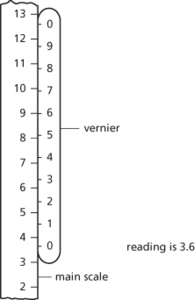A short auxiliary scale placed beside the main scale on a measuring instrument to enable subdivisions of the main scale to be read accurately. The vernier scale is usually calibrated so that each of its divisions is 0.9 of the main scale divisions. The zero on the vernier scale is set to the observed measurement on the main scale and by noting which division on the vernier scale is exactly in line with a main scale division, the second decimal place of the measurement is obtained. The device was invented by Pierre Vernier (1580–1637) in about 1630.

Vernier. Vernier scale.
- information source
- information storage and retrieval
- information structure
- Information Superhighway
- information superhighway
- information system
- information systems
- information technology
- information theory
- informative prior
- INFORMIX
- infospace
- infradian rhythm
- infragravity wave
- infranatant
- Infrared Astronomical Satellite
- infrared astronomy
- infrared chemiluminescence
- infrared cirrus
- infrared excess
- infrared image converter
- infrared interface
- infrared photometry
- infrared photo-polarimeter
- infrared radiation